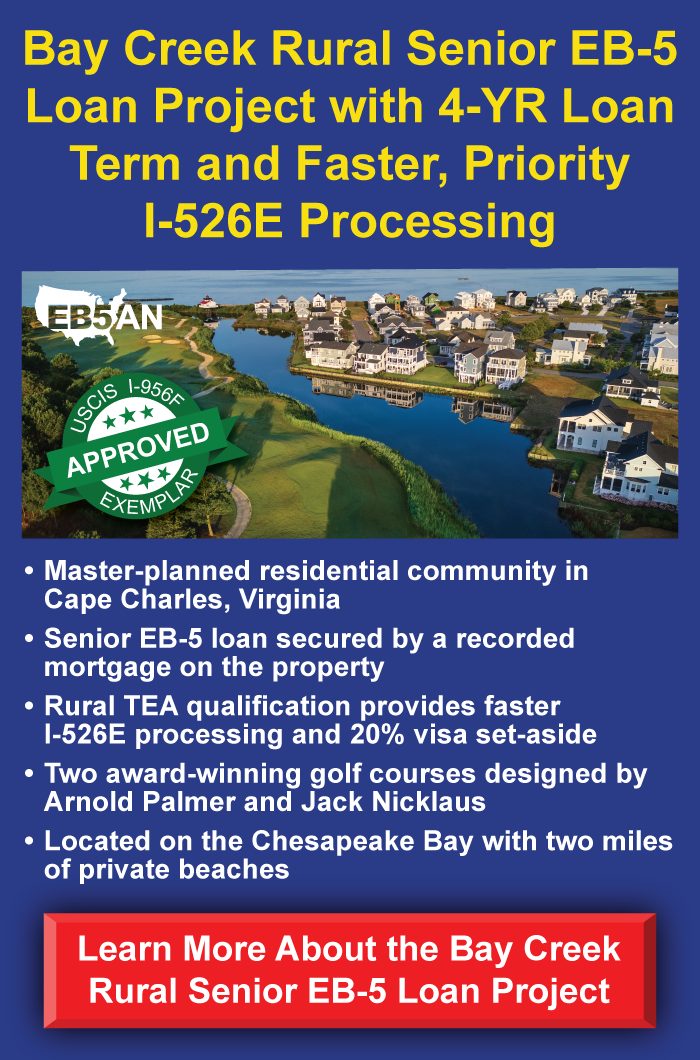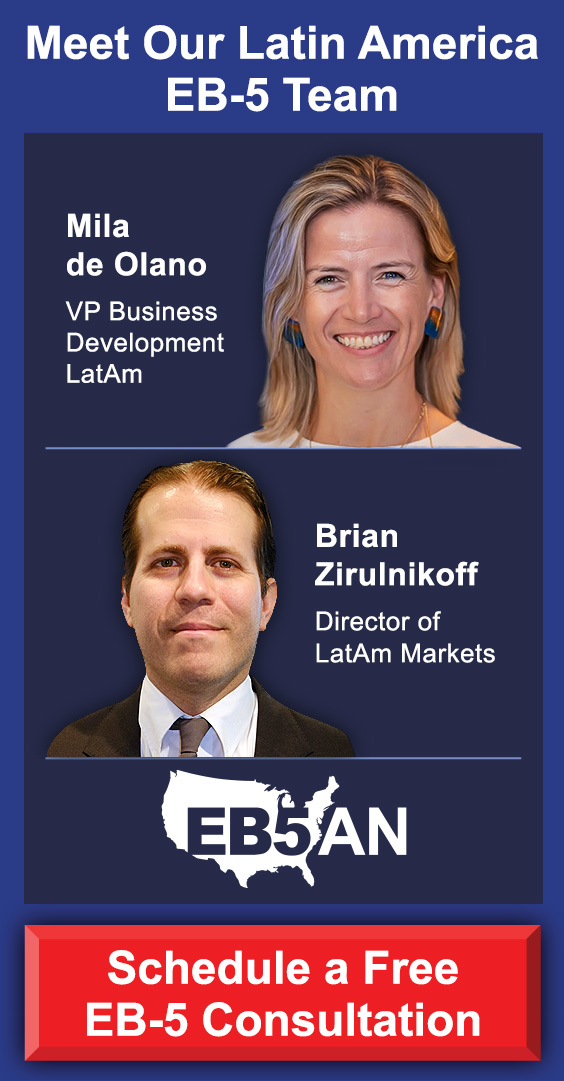Select Highlights of the Interview with Tarun from India
EB-5 Investor in the EB5AN Rocky River Rural EB-5 Project
- “In my past two years where a majority of layoffs have happened across tech, I’ve seen that it creates a lot of uncertainty for H-1B workers. Especially people in the United States where you have just 60 days to find a new job. It’s a very limited time to find a job, plus it is a very unstable position to be in.”
- “I’m not eligible for even O-1 or EB-1A and even if I get an H-1B, the end goal, if I want to stay here in the long term, it is not going to be satisfied with H-1B.”
- “Maybe H-1B is taking too long, don’t fit the O-1, EB-1A criteria and you just want some stability in life and just peace of mind. So then comes down to the same question, what is the cost of peace of mind?”
Full Interview with Tarun from India
EB-5 Investor in the EB5AN Rocky River Rural EB-5 Project
Transcript of the Interview with Tarun from India
Tarun’s Background
Exploring Visa Options and Choosing EB-5
Yeah. So currently, my visa status has been on a student visa, which is STEM OPT. And so there are a couple of options. So one was the H-1B. The other one was the O-1 route as well, which could be later termed as EB-1A. So this was my third attempt with H-1B, so I really didn’t have any luck with getting an H-1B. But I had explored O-1 as well for the extraordinary talent, and a couple of my friends have gone through that process. And by evaluating that option and for EB-1A, I was not the right fit for that particular visa. So that was the gist of the visas I had explored.
And what I’ve usually seen is … In my past two years, where majority of layoffs have happened across tech, I’ve seen that it creates a lot of uncertainty for users, especially people in the United States, where you have just 60 days to find a new job. It’s a very limited time to find a job. Plus, it is a very unstable position to be in.
So those are the options I considered. And looking at that—hey, I’m not eligible for even O-1 or EB-1A—and even if I get an H-1B, the end goal, if I want to stay here in the long term, it is not going to be satisfied with H-1B. So that is when I decided which of the other visa option which maybe I have a shot at, and that’s how I discovered the EB-5 program.
Researching and Hiring an Attorney
Got it, yeah. So it’s a funny story how I discovered even EB-5. I actually didn’t know six months before I made the investment that there is some category called EB-5. So it just happened to be discussed over a conversation with a friend and just mentioned it randomly that one of his friend is going through EB-5. And then this was late May where once I got to know about that, and then I used EB5AN, all the videos—I probably didn’t sleep for two days—and just went through all the videos for what does the process look like, where do you make an investment, what is this thing called source of funds, the entire thing of it. And then I spoke to my wife, that this looks like a good option if you want to pursue. And as she said, “Yeah, okay. Let’s go ahead and do it,” then we decided to come to an attorney—like, “Okay, let’s hire an attorney. Let’s at least get this process started.”
So for the attorney, I had specifically four parameters to select the attorney. So one was the number of cases that the attorney has had, because in a term, I want it to be like, hey, there are a good number of cases that an attorney has seen. So even if there’s an RFE or something like that which we get in the future, the attorney would be able to resolve that.
And the second one was the success rate. Even though an attorney might have had a number of cases but fails everything, that doesn’t matter, which was really important. How many cases has the attorney filed? How many were successful?
And third is what I feel the most interesting was. I was specifically looking at … Because at the time I was filing the EB-5, it was during the election time, so I wanted someone who has gone through at least the two-administration cycle, has filed cases under Democrats and who has filed cases under Republicans. Because, as we have seen, the legal landscape changed very rapidly with one versus the other. So I wanted to see that, hey, someone who has experience in dealing with these two.
And the fourth criteria, which was I think specific to us, was the source of funds. We were initially planning to use a property in India as a source of funds, so we wanted someone who has that specific knowledge on … Because it was very a complicated filing process in India, and there are multiple challenges, so we wanted someone who has experience in dealing with those situations.
So yeah, to summarize the four parameters: number of cases, success rate, different administration, and the source of funds. After looking through these four criteria, I kind of narrowed down on then going ahead and searching like, “Okay, these are the four criteria. This is what I’m looking for. Who would be the best fit for it?”
Luckily, I spoke to Anahita George, and she met all the criteria. It was nice talking to Anahita even in the first call, explaining her the situation, ‘This is what the source of funds look like. This is the property,” and getting to know her. I was like, “Okay, I don’t need to explore anyone else.” I just went ahead with Anahita and didn’t explore any other attorneys for that matter.
When you look at the timelines, May I did the research, hired Anahita in I’d probably say June. And this was particularly for that reason, for the source of funds of selling a property back in India, which was a bit complicated. So that’s when I thought that “Okay, I need this,” because I was planning to make that investment in the next kind of six months or five to six months, but I needed that specific help for that particular property. But if you go look at it, if you have source of funds in the U.S., it is pretty straightforward. And eventually, we didn’t end up using the property as a source of funds. We only used the U.S. source of funds, and it was pretty fast, pretty quick. I’d probably say it was around one or two weeks just getting everything ready.
So the delay doesn’t happen on the attorney side. Anahita is pretty quick, pretty responsive. I was in India, and I sent a message at 11 whatever, and it was very late in the U.S., but still she’s on call and replying. So she’s been very responsive. So that’s why I think the entire process was very straightforward. If you have just U.S. source of funds, the entire process becomes kind of seamless for you.
Yeah, I think out of the four which I mentioned, three are maybe generalized and applicable to everyone who wants to make an investment—the number of cases, the success rate, and different administrations. The fourth one probably is very kind of subjective. It is, hey, if you are someone from China and someone has an experience and if you’re using that kind of source of funds and using a property, the decision might change for you. But eventually, if it’s just U.S. and you have all the three different criteria on the top which I mentioned earlier, I would just say just go with Anahita. I think it’s a no-brainer.
Regional Center Research, Project Selection, and Final Thoughts
Yeah, so again, it goes back to the same question: Okay, what is the criteria for what do you want from this? Eventually, you want a Green Card, and you want to reduce the risk level of that money so you can get it back sometime in the future. So what I was looking at specifically, the three criteria: When do I get my money back, how much risk is involved, and the Green Card timelines.
So I was really narrowing down between two of the projects—specifically was the ONE Tampa and the Rocky River—and applying these three criteria to both of them. So I believe there was a U.S. lawsuit, which is I think going on, on how probably your money is linked to your Green Card even for the urban project for investors from India. So probably that brings a question to the first question: When do you get your money back? So if that is true, then probably you’ll get the money back at the same time whether you invest in a rural or whether you invest in an urban.
The second one was how much risk is involved. Who’s the developer? So I believe both of them was Kolter. So the risk was … Okay, yeah, they have a great track record. They have done everything. And so that is also sorted.
It came down to basically the third point, which is when do you get your Green Card, which is much faster in a rural area because of the much more allocation for the Indian and the Chinese investors. So it nearly came to that point where, okay, if I invest now, when do I actually get my conditional Green Card, part-two Green Card, and eventually the citizenship.
I think the first reason is definitely Kolter, seeing the history of what they target and they’ve already been successful. Twin Lakes was one of the projects, but I think the loan of that … At the point I was investing, there were already too many investors. I was very keen to invest in Twin Lakes, but which is a very similar project to Twin Lakes? It is basically Rocky River. It has all the parameters. It’s closer to the airport. It has whatever you need to have a good lifestyle for a single-family home. That was the second part—okay, where they are situated.
The question again comes down to the point like, “Hey, in order to get your money back, will they be able to sell the projects?” So given Kolter’s track record, I was like, “Okay, they can build it. Can they sell it?” So we have seen that with Twin Lakes and every other property that they are able to sell it.
And the way they look at markets and the positioning that they do is closer to the airport and makes it much more easier for people to make the buying decision, that “Hey, this is the right home for me. It’s a trusted developer. I get the vicinity of the airport.”
And yeah, that’s the criteria when I was looking at, hey, why would I pick Rocky River over any other kind of rural project. It’s primarily comes down to, hey, they’ve done this project in the past, they know what they’re doing, and they know that’s going to … It’s like probability of success. I know that the probability of success is much more higher with Rocky River when I invest with them.
So it goes back to the past performance and the way they’ve handled projects in the past. I think Twin Lakes was also built by them. Like we say in the stock market, past performance does not determine future performance. But in this case, you’re just trying to reduce your probability of failure.
So I have all the information that Kolter has done. I have seen the projects that they’ve built in the past, and I know that they are being successful. So it just becomes kind of … I wouldn’t say an easy, but a straightforward kind of decision where it’s, hey, you know this developer, you know the track record, the history, and the way they build the projects, and the way they sell it is going to be fine. That’s just based on the past record. I don’t know if it goes to, okay, Rocky River turns out to be not good of a project, but this is just based on the past performance and the data that I had on Kolter.
Yeah. So I think it was pretty seamless. So I think when I started my research back in May, I had been in constant touch with Patrick. I was telling him that “Hey, I was planning to invest in Twin Lakes, but if any other projects come up and by the time I make that investment which you’d think is like that, please let me know.” So I think Patrick was absolutely fantastic in just providing the updates, like, “Okay, this is what you’re looking for. This is the risk level.”
This is my own personal perspective—I’ve not spoken to any other regional center—but if you’re going through this process, which is probably close to a million dollars that you’re putting in, so you need more of a guide who has been through this process who’s guiding you through the way. And I feel that Patrick and you were really helpful in just showing me, okay, which projects are there, what is the risk level associated with it, and additionally making the process so fast that even I was like … Okay, I don’t have a reference point, but it was very fast. Within two weeks we had signed. You sent me the documents, I signed it, you uploaded it, the funds were transferred, and it was done.
So I think that was really great from an experience standpoint. From an experience standpoint, it was very great. And I don’t think … Sorry, let me rephrase that. I didn’t have any complaints, to be honest with you, about EB5AN. I believe they exceeded whatever expectations I initially even had. So yeah, it was absolutely great working with EB5AN.
Let’s go back to that question around … When you actually compare this investment, on the face of it, it looks like close to a million-dollar investment. It actually kind of goes to million dollars, because you’re investing $800,000, you’re paying the attorney, you are removing the funds, the subscription details and everything. It goes close to a million dollars.
But if you actually see, the investment amount is more than that. if you had kept this money in the S&P 500, that would’ve given you … And the delta of when you’re investing the money and taking back that money, the delta over 30 years is probably around $8 million. So it’s not the $1 million you’re investing. If you look at 30 years, it’s probably $8 million which you’re kind of looking at, because the S&P 500 gives you a 10% return, assuming you get a 10% return every year. In year zero, you’ve invested that money, but in year seven, when you probably get back your money, that money has already gone to $2 million, where you are now kind of investing $1 million. So when you calculate that over 30 years, it’s probably around $8 million. So it’s a lot of amount when you’re talking about, okay, you are investing this amount of money.
So I would suggest do your research. Look at your situation of where you are in, and if there’s other options that you want to explore, like going through the H-1B or O-1 or EB-1A route, that is fine. That is fine, but explore the options, know what you’re getting from an EB-5 kind of investment.
But the process is great in the terms of sense that, hey, if you don’t have any other options, it’s specifically targeted towards people who don’t fit … Maybe H-1B is taking too long, they don’t fit the O-1, EB-1A criteria, and just want some stability in life and just peace of mind. So then it comes down to the same question: What is the cost of peace of mind?
So I think it’s a very personal decision. I thought, “Yeah, going ahead with this investment is just probably the great thing to do.” Given that, hey, okay, it’s $1 million—I probably can go to India and retire with that money—but I didn’t want to. And I wanted to work, so I was like, “This is the best option for me.” And it was a very personal experience from how I made this decision for EB-5.
But to summarize, overall, it is a great opportunity for folks to stay in the United States long term. And I would suggest look at your criteria for finalizing an attorney, look at the criteria of finalizing your regional center. And just if you think it is the right thing to go ahead with EB-5, definitely go ahead with that.
I would definitely recommend. I don’t think you need to look any further. Just go ahead with Anahita as the attorney and EB5AN as a regional center.
So one of the things which I kind of wanted to bring it back to were the parameters—which, even for the attorneys, and it applies to the regional center as well, it’s the amount of transparency and the responsiveness, which I realized, after going through this process … It was not an initial part of my criteria, but when I went through this process, I’m like, “Holy crap, these people reply within two minutes or so.” But I’ve dealt with lawyers or any other people in tech companies—they probably take a week.
And I realize how important that is, because when you’re making that investment, you definitely need a guide. You need someone to rely, like, “Hey, yeah, okay, whatever they’re saying is the right thing to do.” They’re willing to guide you through the entire process, which becomes very important because the investment is so huge.
To be honest, I don’t have any other reference point. But for whatever experience I had or whatever I expected from that experience was definitely exceeded by both Anahita and you guys at EB5AN. So for me, if I was to recommend someone or a friend or anyone, I would definitely send them your way and Anahita’s way.
Thank you so much, Sam. Really great working with the entire process with you.






